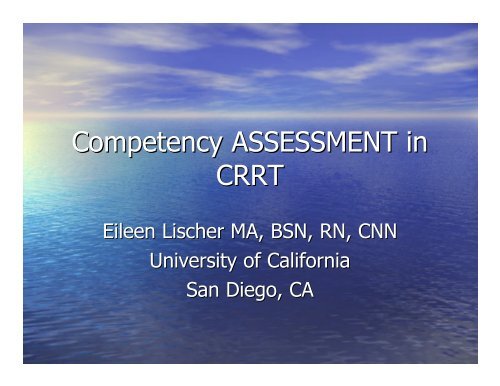Competence - CRRT Online
Competence - CRRT Online
Competence - CRRT Online
- No tags were found...
Create successful ePaper yourself
Turn your PDF publications into a flip-book with our unique Google optimized e-Paper software.
Competency ASSESSMENT in<strong>CRRT</strong>Eileen Lischer MA, BSN, RN, CNNUniversity of CaliforniaSan Diego, CA
Introduction• Competencies can be determined by– Standards established by professionalpractice organizations. (ANNA, AACN)– Job descriptions– Graduation from an accredited program– Licensing exams for practice entry– Continuing Education courses for licenserenewal– Work based programs
<strong>CRRT</strong> certification• There is no national certification for <strong>CRRT</strong>• All competencies are institutional based• Common base of knowledge and skills forall programs• Specific skills and knowledge to eachinstitution and machine.
Definition• Competency is person oriented, referringto the person’s underlying characteristicsand qualities that lead to an effectiveand/or superior performance in a job.• <strong>Competence</strong> is job related-being adescription of an action, behavior oroutcome that a person shoulddemonstrate in their performance.
Required competency elements• For each competency there is– Conceptual understanding -Why– Skills performance- How– Determine all the cognitive components thatare important to the task– Determine what skill set the RN needs toperform the task.- this is based on yourStandards of Practice/job descriptions
Critical Thinking• Didactic class room– Mechanics– Flow pathways– Modalities– Fluid balance– Trouble shooting alarms– Access care– Code Blue
Skills competencies• Priming machine• Flushing and returning blood• Trouble shooting alarms• Care of access• Bag changes• Pressure limits adjustments• Calculating fluid balance• Anticoagulation regulation• Lab draws• Individual equipment skills
Competency Development1. Determine Cognitive informationneeded to perform task2. Determine skill set to perform task3. Determine evaluation method.
Cognitive design• What do you want the nurse to know?-Content• What level are you presenting?– Is this a basic group or your super users• What method of presentation is the best for youraudience?– Classroom- lecture, demonstration etc– Small group– Individual training modules– Keep in mind generational differences to learning
Skills design• What do you want the nurses to be able todo?• Is this a basic skill or advanced?• What evaluation method do you want touse?– Hands on return demonstration– Simulator– 1:1 Mentoring– Skills day
Competency Validation MethodsThere is no one set method for validation of competency. The method selected must compliment the competency andenhance the use of the methodMethod Use/Intent Weakness Additional considerationsTest/ ExamReturn DemonstrationDaily WorkCase StudiesExemplarsPeer ReviewMeasure attainment ofcognitive informationTechnical SkillCan be used in artificial or realsettingCapture skills done on aneveryday basisCritical thinking skills - can becombined with discussionCritical thinking & interpersonalskillMay assess appropriate actionsNOT takenInterpersonal skills, criticalthinkingo Must be safe for theperson giving thefeedbacko Must be safe for theperson receiving theDoes not measure behavior,performance, psychomotorskillsUse in real world only if it will notharm patientsDo not measure interpersonalor critical thinking skillsAbility to capture anddocumentDifficult to measurepsychomotor skillsUnable to assess psy cho motorperformanceCannot measure all aspects ofjobWhat is the acceptable score?Are there elements that musthave 100% ScoreNeed uniform documentedevaluation criteriaUse other teammembers/departments topromote team building2 methods creation of a storyw/ question following Identifyquestions and have employeesuse their own real life situationsWritten by the employee -describe, explain rationaleCan be used for many jobclassificationsAble to assess actions nottaken as wellKeep short and focused“peers” see you do the job -may not be in the same jobclass
Continuing Competencies• Organization needs to determine– How often to reevaluate skill competencies?– Which skills to focus on-low frequency/highsafety risk or high frequency/ high risk?– How to determine a need for refreshercourse?• CQI projects• Multidisciplinary <strong>CRRT</strong> committee input– When do standards need to be raised?
Identifying Ongoing Needs• Quality variance reporting• Data collection/ Audit tool• Antidotal information• Walking rounds• Multidisciplinary committee input• New policies• New equipment
Success• Involve bedside nurse• Use your champions• Promote a culture of safety not shame andblame• Give a consistent message















